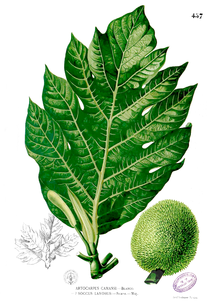User:Alvin.ho.90/sandbox
| Artocarpus camansi | |
|---|---|

| |
| Artocarpus camansi | |
| Scientific classification | |
| Kingdom: | |
| (unranked): | |
| (unranked): | |
| Order: | |
| Family: | |
| Genus: | |
| Species: | camansi
|
| Binomial name | |
| Artocarpus camansi | |
The breadnut, Artocarpus camansi, is a medium sized tree found in the mulberry family Moraceae. Native to Papua New Guinea, it is a relative of the breadfruit and is commonly used as a staple crop.[1] Common names for plant also include chataigne, breadnut, 'pana de pepita' or 'castaña' in the Carribean,'kamansi' in the Philippines, and 'kapiak' in New Guinea. [2] [1]
Distribution and Origins[edit]
Artocarpus camansi is endemic to New Guinea and possibly Indonesia and the Philippines.[1] The ambiguity of the origins of this plant is a result of spread and domestication of multiple species of breadfruit, Artocarpus camansi included, as humans spread from island to island in the Pacific. There is speculation that breadfruit, Artocarpus altilus, the most widely used breadfruit, was selectively bred from Artocarpus camansi. If it indeed is the case, then the breadnut would be very significant to the original colonizers of the Pacific Islands because breadfruit was and still is a staple crop and would have contributed to viable human populations on those islands.[3]
Habitat and Ecology[edit]
Breadnut trees can usually be found in tropical environments along low lying areas at an elevation between 0-1550 m (0-4950 ft), inundated riverbanks, and in freshwater swamps.[1] Additionally, the plant grows best at a mean annual temperature between 15-40° C (50-104° F) in deep, well drained soil with a neutral to alkaline soil acidity.[1] [4]
Morphology, Flowers and Fruit[edit]
The morphology of the breadfruit is a tree up to 35 m tall with leaves 40-60 cm long and 25-45 cm wide and are pinnately lobed.[4] The plant is monoecious and the male and female flowers occur at the tips of branches.[1] Each male flower have two anthers each and is 3 cm in diameter and 25-35 cm long. Additionally, each male flower is club shaped and thousands of male flowers are grouped together in an inflorescence.[1]
The fruit is globular, weighing 800 g (1.8 lb) and are 16-20 cm long by 8-15 cm wide with a yellow-green color and each mature tree can produce 600-800 fruits per year.[4] [1] Additionally, when ripe, the interior of the fruit is off white with a sweet taste and aroma.[1] The fruit of the breadnut is mostly seed and the number of seeds per fruit can range from 12 to 150 per fruit at a mass of around 7 to 10 g per seed.[1] The seed of the fruit are normally spread by flying fox and other mammals.[1]
Food and Economic Value[edit]
Although not as commonly eaten as the breadfruit, it is an important crop in New Guinea, where the breadnut is a staple crop. Usually the fruit is consumed when it is immature and thinly sliced pieces are boiled in soups. Additionally, the seeds are also of economic value in the Caribbean, Central and South America because they taste similarly to chestnuts. As a result, the seeds can be roasted, canned, or processed into paste, butter, flour or oil.[1]
References[edit]
- ^ a b c d e f g h i j k l Ragone, Diane (April 2006). "Artocarpus camansi (breadfruit)". Species Profiles for Pacific Island Agroforestry. 2 (1).
{{cite journal}}: CS1 maint: date and year (link) - ^ Roberts-Nkrumah, Laura B. (2005). "Fruit and Seed yields in chataigne (Artocarpus camansi Blanco) in Trinidad and Tobago". Fruits. 60 (6): 387–393. doi:10.1051/fruits:2005044. Retrieved 18 April 2012.
- ^ Zerega, Nyree J. C.; Ragone, Diane; Motley, Timothy J. (2004). "Complex Origins of Breadfruit (Artocarpus altilus, Moraceae): Implications for Human Migrations in Oceania". American Journal of Botany. 91 (5): 760–766. doi:10.3732/ajb.91.5.760. PMID 21653430. Retrieved 18 April 2012.
{{cite journal}}: CS1 maint: date and year (link) - ^ a b Zerega, Nyree J. C.; Ragone, Diane; Motley, Timothy J. (2005). "Systematics and Species Limits of Breadfruit (Artocarpus, Moraceae)". Systemic Botany. 30 (3): 603–615. doi:10.1600/0363644054782134. Retrieved 603-615.
{{cite journal}}: Check date values in:|accessdate=(help)CS1 maint: date and year (link)

